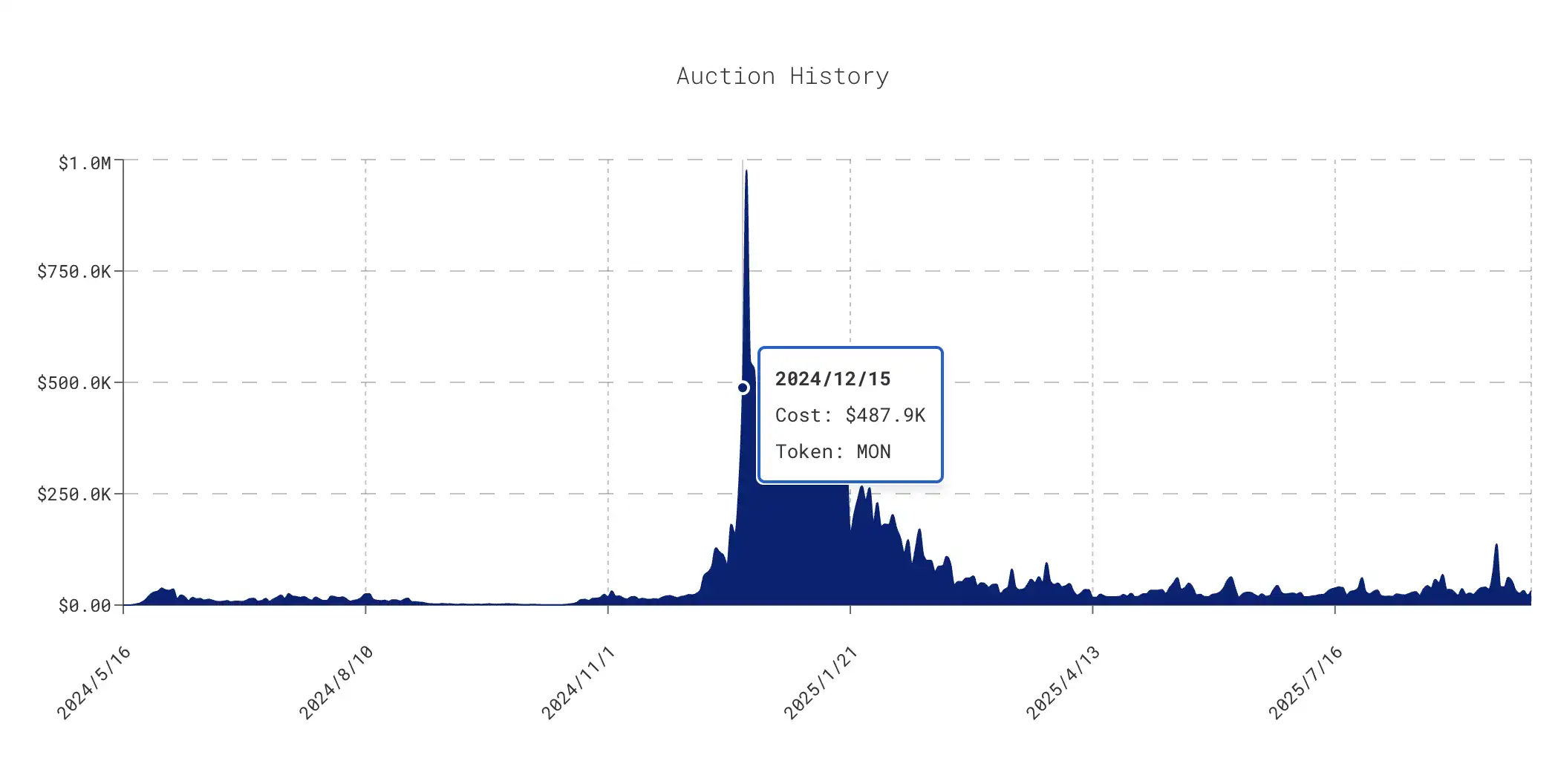Hyperliquid is undoubtedly the brightest star in the crypto space this year.
However, a recent dispute over "naming rights" has sparked considerable debate and division within the community.
If you spent $500,000 on Hyperliquid to buy a token code (Ticker), would you assume it belongs to you? The Hyperliquid team recently provided an answer through their actions: it belongs to you on-chain, but I manage it on the webpage.
$MON bought for $500,000, just gone?
The focus of the controversy stems from January of this year. At that time, Mon Protocol, behind the GameFi project Pixelmon, participated in Hyperliquid's HIP-1 spot listing auction to attract the Hyperliquid community.
Here, a brief explanation of Hyperliquid's spot listing mechanism is needed. Unlike centralized exchanges that charge "listing fees" or "bribes," HL uses a Dutch auction bidding process for listings. This is a permissionless process where project teams bid by paying Gas fees (initially using USDC, later changed to HYPE) to compete for listing qualifications.
Mon Protocol spent approximately $500,000 to win the auction at a high price, successfully registering the Ticker $MON on-chain.
At that time, Hyperliquid's spot market was still in its early stages, and the spot bridging project Unit had not yet launched. Other spot trading pairs, aside from large market cap tokens like HYPE and PURR, generally lacked liquidity, and Mon Protocol's token performed almost like a rug pull after its launch.

Monad, a highly anticipated "king-level project," also has the token called $MON. So when Monad landed on Hyperliquid, an awkward scene unfolded: the Hyperliquid team directly modified the front-end display, forcing Mon Protocol to be renamed "MONPRO" on the front-end, while Monad directly used the name "MON."

Although on-chain, Pixelmon's token code remains MON, and Monad is actually UMON, the "name" that Pixelmon spent $500,000 to acquire was instantly stripped away in the most direct user perception on the front-end.
User safety or traffic supremacy?
This action quickly ignited public opinion on Twitter. Trader Akku bluntly stated that this decision was "extremely disappointing."
"Pixelmon spent $500,000 on something that can be arbitrarily overwritten on the front-end, while Monad (or its closely related Unit) can obtain this visible name without spending any money… Does this mean: you can buy the on-chain code, but we will decide what the front-end displays based on who we have good relations with?"
In response to the criticism, Hyperliquid's core member xulian provided a very "Web2" explanation:
"The most important factor for the front-end is to protect users. Buying the wrong token is bad for everyone. As far as I know, all major exchanges changed MON to MONPRO weeks ago. The auction is on-chain Gas fees, and the Mon Protocol team still owns the MON Ticker. Any other front-end can name it as they wish."
This statement translates to: To prevent user confusion, we sacrificed the display rights of the original Ticker owner.
Another party involved in this incident, the Unit team closely related to Hyperliquid (responsible for the spot bridging of the Monad token on HL), was also drawn into the controversy due to acquiring this name. Unit member Shadow (0xmev) was forced to clarify:
"The protocol and the app are two different things. Hyperliquid Labs has decision-making power over the app. This matter is very clear: one is a project (Mon Protocol) that failed to attract the Hyperliquid community's buying interest, and its token price went to zero; the other is a high-profile, high-trading-volume project (Monad) that came in. Labs felt that giving the name to the latter was a better display choice."
Community uproar
Although the official explanation holds logically (the front-end indeed belongs to Hyperliquid Labs), the community does not buy it in terms of sentiment and business ethics.
Akku countered that the marketing of the spot auction initially led everyone to assume "spot listing = front-end display," and now playing word games to say it is "only on-chain" is akin to a marketing scam. He believes that if Monad did not want a conflict, they should change their name themselves, rather than stripping the rights of the first comers.
Ramen's viewpoint represents the voice of most onlookers:
"To avoid confusion by displaying $MON for Monad may be correct, but forcibly renaming after they paid $500,000 is wrong. A refund seems to be the best course of action."
Of course, there are voices defending HL. Users aaalex.hl and altoshi insist that "the protocol does not equal the front-end," and "Hyperliquid is in business, not charity," arguing that as long as the on-chain contract has not changed, it does not violate the principles of decentralization.
"Arrogance" is a byproduct of success
Hyperliquid did not do anything wrong. They indeed have absolute control over the domain hyperliquid.xyz and have the right to adjust the display logic for user experience. The size and attention of Monad far exceed that of Pixelmon, and allowing Monad to use the MON code not only aligns with the platform's interests but also protects uninformed users from buying a similarly named illiquid token.
This seemingly reasonable "autocracy" can, in fact, make some ecosystem builders feel uneasy.
Absolute interpretative power
Another story revealed by Unit team member Shadow in his response may be more thought-provoking than the renaming incident itself:
"We built the entire brand (tradexyz) ourselves precisely because we had no influence over Labs' front-end decisions. They ultimately decided to launch HIP-3 on their official front-end immediately after we completed and announced the entire project—this effectively destroyed the competitive advantage we spent a lot of time building. But we won't complain about it; we will keep moving forward."
If even a "direct subordinate" like Unit can be "sucked dry" by the official front-end at any time, how can small projects with no background find a sense of security in such an ecosystem?
Clumsy handling
Hyperliquid's "arrogance" towards capital is a significant factor in winning the community's fervent support. They refuse investments from top VCs, reject paying listing fees to CEXs, and insist on fair distribution.
But as Akku pointed out, even refunding the auction fees from that year or reaching some compensation agreement with the Pixelmon team in advance could have made this matter much more dignified. The current approach not only harms early supporters (even if it is a failed project) but also sends a signal to the outside world that "whoever is bigger is right."
Hyperliquid remains one of the best Perp DEXs in the market today, and its technical strength is beyond doubt. However, after reaching the top, how to avoid becoming the "autocratic giant" they initially sought to overturn may be a question the Hyperliquid team needs to ponder.
Water can carry a boat, but it can also capsize it. The "arrogance" that the community appreciates is the resilience in the face of power, not the capriciousness in the face of rules.
免责声明:本文章仅代表作者个人观点,不代表本平台的立场和观点。本文章仅供信息分享,不构成对任何人的任何投资建议。用户与作者之间的任何争议,与本平台无关。如网页中刊载的文章或图片涉及侵权,请提供相关的权利证明和身份证明发送邮件到support@aicoin.com,本平台相关工作人员将会进行核查。
 Source:
Source: 



